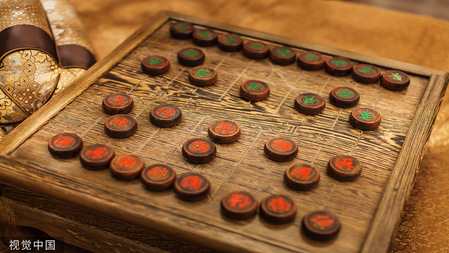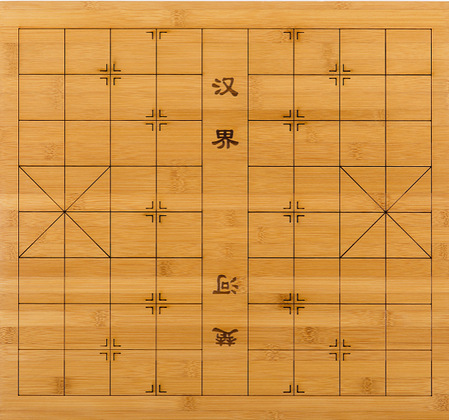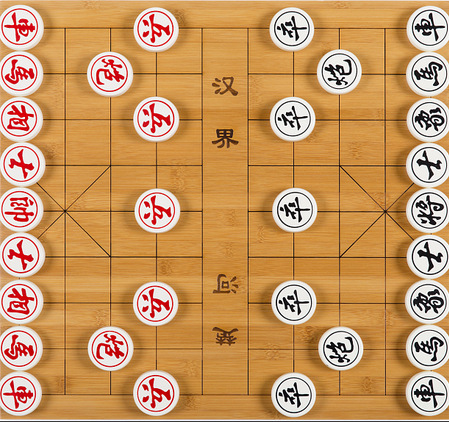中国象棋(Xiangqi)
一、象棋历史与发展
History and Development of Xiangqi
中国象棋历史悠久,
是中国传统文化的重要组成部分,
2008年入选中国非物质文化遗产名录,
在中国和亚洲乃至世界很多地区都有象棋爱好者,
是一项普及性比较高的传统智力竞技游戏。[1]
Chinese Xiangqi has a long history,
is an important part of traditional Chinese culture.
It was inscribed on the Chinese Intangible Cultural Heritage list in 2008
and is a relatively popular traditional game of intellectual competition
with fans in China and many parts of Asia and the world. [1]

(象棋 Chinese Xiangqi)
象棋的起源说法不一,
但国际仍以印度起源说为主。
印度的【恰图兰卡】经丝绸之路传入中国,
在朝代更替中渐渐演变,
最后在宋代改造成中国象棋。[2]
The origin of Chinese Xiangqi varies,
but internationally the Indian origin is still dominant.
The Indian [Chaturanga] was introduced to China via the Silk Road
and gradually evolved through dynastic changes,
finally being transformed into Chinese chess during the Song Dynasty. [2]
2009年,
为推动象棋在世界范围的普及和发展,
“中国象棋”更名为“象棋”
英文译名采用“Xiangqi”。[3]
In 2009,
in order to promote the popularity and development of chess worldwide,
the name 中国象棋 was changed to 象棋
and the English translation Xiangqi was adopted. [3]
二、棋具与规则介绍
Introduction to Chess Sets and Rules
棋盘
棋子活动的场所,叫作“棋盘”。
在方形的平面上,
由九条平行的竖线和十条平行的横线相交组成,
共有九十个交叉点,
棋子只能交叉点上移动。
棋盘的第五,第六两横线之间
未画竖线的空白地带称为“河界”。
第四条到第六条竖线之间的正方形部位,以斜交叉线构成“米”字方格的地方,
叫作“九宫”。
整个棋盘以“河界”分为相等的两部分。[3]
The chessboard
The board is the place where the pieces move around.
On a square board,
nine parallel vertical lines and ten parallel horizontal lines intersect,
making a total of ninety points of intersection on which the pieces can only move.
The blank area between the fifth and sixth horizontal lines of the board,
where no vertical lines are drawn,
is called the 'river boundary'.
The square area between the fourth and sixth vertical lines,
where the diagonal crosses form a 米 square,
is called the Nine Palaces.
The entire board is divided into two equal parts by the river border. [3]

(棋盘 The chessboard)
棋子
中国象棋使用方形格状棋盘,
圆形棋子共有32个,
红、黑各16个,
共有7种类型的棋子,
其名称和数目如下:
红棋子:帅一个,
车、马、炮、相、仕各两个,
兵五个。
黑棋子:将一个,
车、马、炮、象、士各两个,
卒五个。
Chess pieces
Xiangqi is played on a square board
with 32 circular pieces,
16 each in red and black.
There are 7 types of pieces
with the following names and numbers:
red pieces: one marshal,
two rooks, two knights, two cannons, two phases
and five pawns.
Black discs: one general,
two rooks, knights, cannons, bishops and pawns,
and five pawns.
“车”和“炮”可以横向或竖向移动数格,
“马”走“日”字,
“相”(“象”)走“田”字,
但不能超过“河界”,
其余棋子每次移动只能走一格,
“帅”(“将”)和“仕”(“士”)
只能在“九宫”内移动。[3]
The rook and cannon may be moved horizontally or vertically by a few squares,
the knight goes to the 日,
and the bishop goes to the 田.
The phase (bishop) moves to the 田,
but not beyond the river,
the rest of the pieces can only move one square at a time.
The rest of the pieces can only move one square at a time,
the marshal (general) and the servant (soldier)
can only move within the nine palaces. [3]
规则
帅和将是双方的将领,
阵亡的一方判负。
两人轮流走子,
由执红棋的一方先走,
双方轮流各走一招,
直至分出胜、负、和。
Rules
The marshal and the general are the generals of both players,
the player who is killed in battle is awarded a loss.
The two players take turns,
with the player holding the red pieces going first.
Both players take turns to make one move each
until a winner, loser or draw is determined.

(摆放规则 The rule of putting)
三、价值与前景展望
Values and Prospects
象棋有着严密的逻辑思维,
每动一子都可能影响全盘局势和应变机会,
充满了思维辩证哲学。
如一昧进攻往往收效甚微,
防守反击却能收获奇效。
除此之外,
象棋还可以培养良好的记忆力和空间想象力。
Xiangqi is a game of rigorous logic,
where every move can affect the whole game and its chances of success,
and is full of dialectical philosophy. Whereas attacking is often ineffective, counter-attacking can be very effective.
In addition,
Xiangqi develops a good memory and spatial imagination.
棋盘中的九宫象征皇宫,
代表皇帝的帅(将)及代表皇帝身边的士只能在“九宫”中活动,
代表大臣的象(相)则只能围绕“九宫”行走,
代表战士的兵(卒)只能前进不能后退。这种布局是中国封建社会生活的真实写照,
其对弈过程有教导、学习古代战争的意义。
The nine palaces on the chessboard symbolise the imperial palace,
the marshal (general) representing the emperor and the taxis around him can only move around the nine palaces,
the bishop (phase) representing the minister can only walk around the nine palaces
and the pawn (pawn) representing the warrior can only move forward but not backward.
This layout is a true reflection of life in feudal China,
and the process of playing the game has the significance of teaching and learning about ancient warfare.
尽管象棋具有多种重要功能,
在中国乃至世界都有爱好者,
但随着经济的发展,
现代社会生活方式对传统文化体育项目造成了很大的冲击,
象棋这一古老国粹也面临着新的危机,
同样有待保护。[1]
Despite its many important functions
and the fact that it has enthusiasts in China and the world,
the ancient national treasure of Xiangqi is facing a new crisis
with the development of the economy and the impact of modern social lifestyles on traditional cultural sports,
and is equally in need of preservation. [1]
参考文献:
[1]中国非物质文化遗产网.https://www.ihchina.cn/Article/Index/detail?id=13814.
[2]陈居渊.“易象”新说--兼论《周易》原有《象经》问题[J].周易研究,2012(01),43-49.
[3]百度百科.https://baike.baidu.com/item/%E8%B1%A1%E6%A3%8B/30665?fr=aladdin.
(策划/ 石牌校区学生党支部 文字/ 周凯 图片/ 来源网络 编辑/ 冯欣 初审/ 方葳、尹秋颖 终审/ 刘明)





